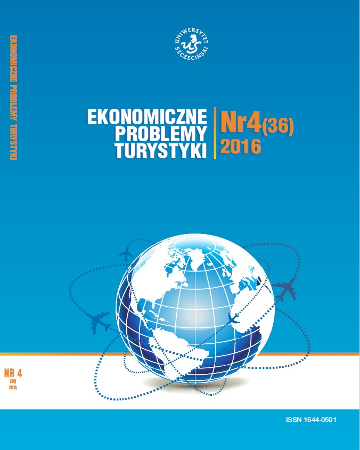
ISSN: 1644-0501
eISSN: 2353-3188
OAI
DOI: 10.18276/ept.2016.4.36-16



Issue archive /
nr 4 (36) 2016
Hiking Trails as the Tourist Potential of Szczytna City and Municipality
| Authors: |
Eleonora
Gonda-Soroczyńska
Wrocław University of Environmental and Life Sciences, POLAND Iga Wiktoria Michalak Wrocław University of Environmental and Life Sciences, POLAND |
| Keywords: | tourist management hiking trails tourist potential tourism Szczytna |
| Data publikacji całości: | 2016 |
| Page range: | 12 (173-184) |
Abstract
The presented research highlights the tourist potential of Szczytna city and municipality located in Lower Silesia Province, close to such popular spa and health resorts as Polanica-Zdrój, DusznikiZdrój and Kudowa-Zdrój. Special attention was devoted to hiking trails, identified as the factors which attract and will continue to attract both tourists and the potential investors. Szczytna city and municipality offer few architectural relics of the past, historic elements of small architecture, interesting forms of nature protection, e.g.: Stołowe Mountains National Park [Table Mountains National Park], Peatbog in the vicinity of Zieleniec (nature reserve), Bystrzyckie and Orlickie Mountains (protected landscape area), Nature 2000 area, 8 nature monuments. All the above mentioned elements can be admired while hiking along tourist trails. Currently their length amounts to approx. 115 km in the area of Szczytna municipality. Within the framework of the conducted research over 70 km of them were analysed. The length and density of hiking trails implies high attractiveness of the studied area, therefore the places presenting extensive tourist potential were covered by the analysis. The valorisation of hiking trails was based on Wejchert’s impression curve method, which allowed their evaluation. On the grounds of its results the sites adequate for new tourist investments were identified.
Download file
Article file
Bibliography
| 1. | Dudzińska, A., Świerk, D., Jeleniewska, M., Urbański, P. (2014). Perception-Based Valuation of Landscape in the Area around Lake Rusałka in Poznań, Poland, Using Wejchert’s Impression Curve Method. Barometr Regionalny, 12 (1), 79–88. |
| 2. | Gaworecki, W.W. (2003). Turystyka. Warszawa: PWE. |
| 3. | Gonda-Soroczyńska, E. (2010). Elementy zagospodarowania turystycznego w Karpaczu. Problemy Ekologii Krajobrazu, XXVI, 375–384. |
| 4. | Gonda-Soroczyńska, E. (2014) Wielofunkcyjność czy jednofunkcyjność? Uzdrowiska w obliczu przemian przestrzennych? Prace Naukowe Uniwersytetu Ekonomicznego we Wrocławiu, 367, 68–75. |
| 5. | Gordon, A. (ed.) (2003). Turystyka w gminie i powiecie (pp. 116–119). Warszawa: Polska Organizacja Turystyczna. |
| 6. | Hopfer, A., Cymerman, R., Nowak, A. (1982). Ocena i waloryzacja gruntów wiejskich (pp. 128–142). Warszawa: Państwowe Wydawnictwo Rolnicze i Leśne. |
| 7. | Kurek, W. (2008). Turystyka. Warszawa: Wydawnictwo Naukowe PWN. |
| 8. | Mordwa, S. (2009). Krzywa wrażeń dla ulicy Piotrkowskiej w Łodzi. Acta Universitatis Lodziensis. Folia Geographica Socio-Oeconomica, 10, 89–98. |
| 9. | Obidziński, A., Żelazo, J. (red.) (2011). Inwentaryzacja i waloryzacja przyrodnicza (pp. 109–110). Warszawa: Szkoła Główna Gospodarstwa Wiejskiego. |
| 10. | Petryszyn, J., Zuzańska-Żyśko, E. (2008). Od funkcji przemysłowej do turystycznej – przykład Ustronia (pp. 133–144). In: I. Jażdżewska (ed.), Funkcja turystyczna miast. XXI Konwersatorium Wiedzy o Mieście. Łódź: UŁ. |
| 11. | Pilch, J. (1978). Leksykon zabytków architektury Dolnego Śląska. Warszawa: Arkady 2005. |
| 12. | Rejestr pomników przyrody w województwie dolnośląskim, http://bip.wroclaw.rdos.gov.pl/rejestr-form-ochrony-przyrody. |
| 13. | Staffa, M. (1996). Słownik geografii turystycznej Sudetów. T. 13. Góry Stołowe (pp. 236–241). Warszawa: PTTK “Kraj”. |
| 14. | Website http://crfop.gdos.gov.pl/CRFOP/search.jsf. |